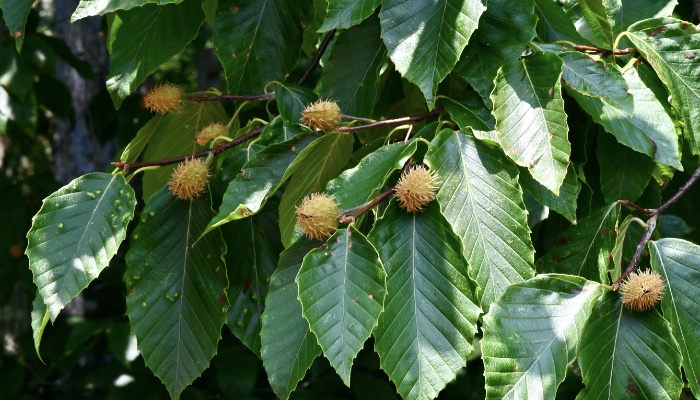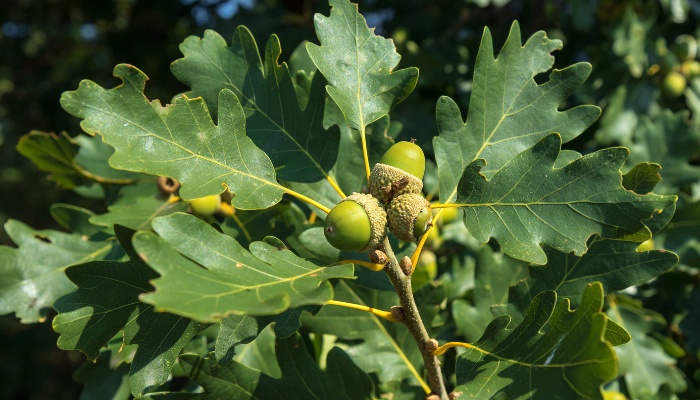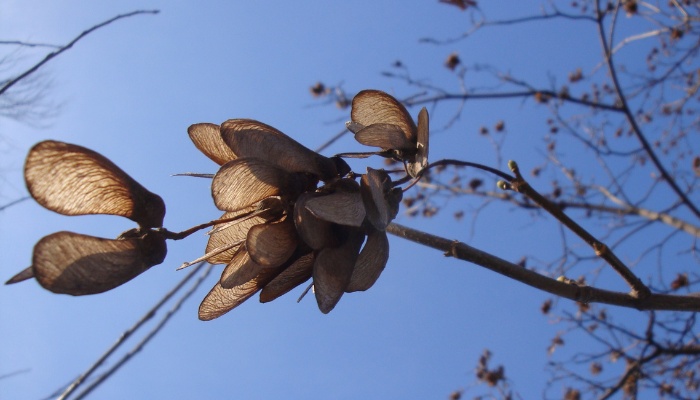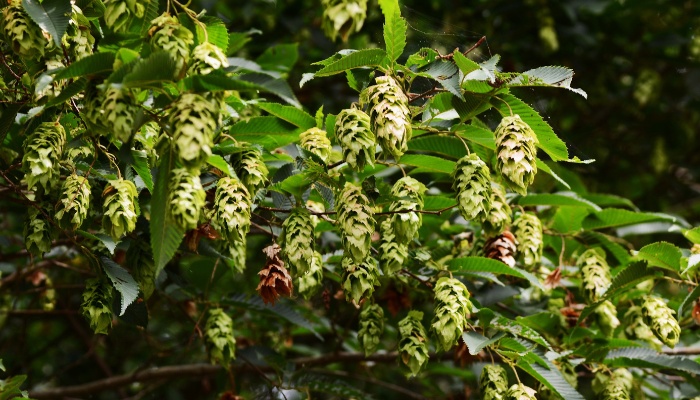Despite its restricted Growing Zones, North Carolina boasts a considerable amount of nut trees that possess strong tolerance to varying temperatures and tough weather conditions.
Not only that, but some of these trees have perfectly edible nuts that you can use in different recipes or eat raw.
The following guide unveils some of the best nut trees with edible fruits that grow in North Carolina.
Admittedly, some of these nut trees have more ornamental values than others. Read more to find out which tree with edible nuts you can grow in your yard.
1. Black Walnut

The black walnut has precious wood with smooth and straight grain. This is why the tree almost became extinct.
The tree is tall with dark bark, and the leaves have toothed edges. The crown is round and dense, and the first branches are high up the trunk.
It starts producing nuts about 15 years after planting. The nuts have exceptional flavors and taste and go into everything from ice cream to baked goods.
- Mature size: 70 to 80 feet
- Key identifying features: Dark, heavily ridged bark, toothed leaves
- Years to reach maturity: 12 to 15 years
- Grow Zones: 4-9
2. Pecan

The pecan tree is often mistaken for the hickory tree. They’re close cousins and bear many resemblances.
The pecan tree, which is native to the United States, has nuts that go into many desserts such as pies and cakes.
However, the nuts you will get from a native pecan tree might be smaller with little flesh compared to the pecans you buy at the store.
The tree is tall, stately, and starts fruiting 20 to 25 years after planting.
- Mature size: 70 to 100 feet
- Key identifying features: Pointed and slightly curved leaves, oblong nuts
- Years to reach maturity: 20 to 25 years
- Grow Zones: 5-9
3. Butternut

Whether you call it the butternut or white walnut, this tree has a medium size and distinguishing pale gray bark when the tree matures. The nuts are oblong and grow in a husk with sticky hair all over it.
The oily nuts are extremely delicious and sweet. It takes the tree about 20 years to mature and produce nuts. It favors damp soil and grows in ravines and near water streams.
- Mature size: 40 to 60 feet
- Key identifying features: Mature pale gray bark, sharply ridged nuts
- Years to reach maturity: 20 years
- Grow Zones: 2-3
4. Hickory

The hickory is a giant tree known for its gray bark with deep ridges. When the tree matures after 20 years, the bark peels easily.
Hickory is sought after for its fine wood that goes into making furniture and tool handles.
The tree averages between 70 and 80 feet and grows well in Zones 4 to 8. The nuts are not as tasty as pecans, but they can be eaten roasted.
- Mature size: 70 to 80 feet
- Key identifying features: Bark is ridged, gray, and peels easily
- Years to reach maturity: 20 years
- Grow Zones: 4-8
5. Chestnut

Chestnut trees almost went extinct in North America after the chestnut blight.
Many of the chestnut trees growing in the wild these days are infected with fungus, so you should think carefully before introducing this tree into your garden.
It grows to about 80 feet and has toothed leaves and furrowed bark. The nuts grow inside brown shells and have a sweet taste.
- Mature size: 80 feet
- Key identifying features: Furrowed bark, toothed leaves
- Years to reach maturity: 15 to 20 years
- Grow Zones: 4-9
6. Hazelnut

The hazelnut is a relatively small tree compared to the other trees on this list. It grows to about 18 feet tall and reaches maturity after only 8 years.
The tree is easy to identify with its gray-brown bark and fine hairs around the stems of the leaves.
The nuts are a good substitute for cocoa and are used to make coffee. Hazelnut trees grow well in Zones 4 to 9.
- Mature size: 15 to 18 feet
- Key identifying features: Smooth, gray-brown bark, hairy stems, leaf buds are oval
- Years to reach maturity: 8 years
- Grow Zones: 4-9
7. Common Chinquapin

The easiest way to identify the common chinquapin is to look at the leaves. They have a unique oblong-lanceolate shape with toothed edges.
The tree grows to about 50 feet at most and starts fruiting after 30 years. The nuts are small and sweet and were once favored by Native Americans.
- Mature size: 40 to 50 feet
- Key identifying features: Coarsely toothed oblong-lanceolate leaves
- Years to reach maturity: 30 years
- Grow Zones: 5-9
8. Beech

The beech tree is known among other things for its smooth gray bark. When the tree matures after about 40 to 60 years, the thin bark is easy to peel.
The leaves are oval and ribbed. The mature tree can reach about 70 feet tall. The nuts are about 2.5 inches long and have good flavors.
- Mature size: 50 to 70 feet
- Key identifying features: Smooth, thin gray bark and toothed, ribbed oval leaves
- Years to reach maturity: 40 to 60 years
- Grow Zones: 4-9
9. Oak

Oak trees are known for the hard wood they produce. The wood goes into making furniture, tool handles, and sailing ships among various other things.
The tree is resistant to mites and the elements. Oaks are easy to identify with their gray and scaly bark.
They grow to about 80 feet tall and are best suited for warm Zones between 7 and 10. Oaks produce acorns after 20 years, and the nuts take about 18 months to ripen.
- Mature size: 40 to 80 feet
- Key identifying features: Hard, gray, and scaly bark
- Years to reach maturity: 20 years
- Grow Zones: 7-10
10. Birch

Birch trees are medium-sized and have smooth bark. The bark is often white but can be other colors. It’s often covered by resin.
The trees produce winged oval nuts about 20 years after planting.
- Mature size: 30 to 50 feet
- Key identifying features: Smooth, resinous, white or colored bark
- Years to reach maturity: 20 years
- Grow Zones: 2-6
11. Alder

Alder is a deciduous tree with serrated leaves. The bark turns dark when the tree matures and is covered with fissures.
The mature tree doesn’t grow above 50 feet but takes up to 70 years to produce fruits.
- Mature size: 40 to 50 feet
- Key identifying features: Conical shape, bark is dark and fissured
- Years to reach maturity: 60 to 70 years
- Grow Zones: 5-8
12. Eastern Ironwood

This is a small and deciduous tree with brown and uneven bark. The leaves are heart-shaped and doubly serrated.
Eastern ironwood trees produce nuts after 20 years. The nuts are small, about a half-inch long, and they turn brown when they mature.
- Mature size: 25 to 40 feet
- Key identifying features: Deciduous with heart-shaped leaves
- Years to reach maturity: 20 years
- Grow Zones: 3-9
13. Hornbeam

Hornbeams grow well in Zones 3 to 9. They can reach 90 feet tall and have gray bark with distinguishing vertical markings.
They flower in the spring, and after pollination, small nuts develop. The nuts are oval and surrounded by asymmetrical wings, so they spin when they fall.
- Mature size: 90 feet
- Key identifying features: Pale gray bark with vertical markings
- Years to reach maturity: 30 years
- Grow Zones: 3-9
Final Thoughts
Some of the nut trees that grow in North Carolina can take years to mature and bear nuts. Others are quick to produce their delicious fruits after just a few years from planting.
However, that shouldn’t be the only factor when considering a nut tree in your garden.
Space, ornamental values, and the tree’s ability to withstand pests and diseases should be decisive factors to help you make your selection as well.
